FRUIT PRODUCTION
Michigan is one of the major fruit-growing states, in large part because of the
lake-effect climate which makes for favorable fruit production near the lakes. Also, our
soils are sandy and fertile, which favors the deep-rooted trees. Michigan's fruit belt
runs the length of the lower peninsula, for several kilometers near Lake Michigan.
Dominant westerly winds create a lake effect climate in this belt that is very favorable
to fruit production.
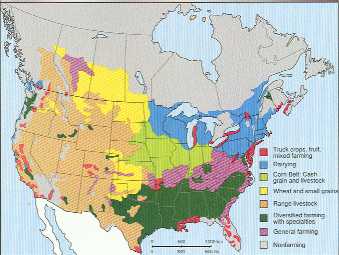
Click here for full size image (346 kb)
Source: Unknown
Local conditions give rise to greater fertility and special types of agricultural
production, like fruit. Examples are the important cherry areas in the vicinity of Grand
Traverse Bay and further south in the Hart-Shelby area of Oceana County. These
concentrated fruit belts are related to factors such as sandy loam soils and their
nearness to Lake Michigan. The lake retards the first frost in the fall and also keeps the
area cool in the spring until there is considerable assurance that frost will not recur.
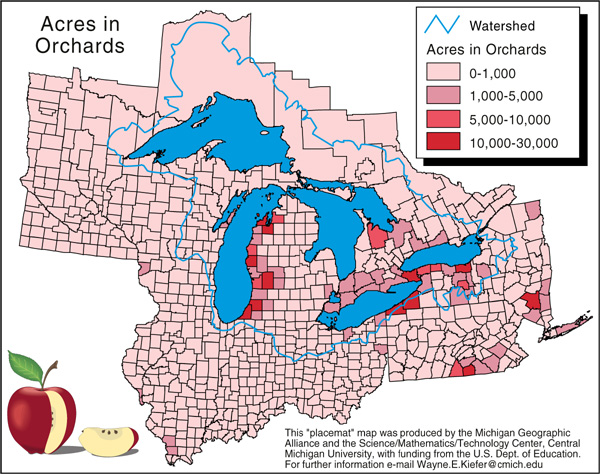
Why is the fruit belt where it is?
Source: Central Michigan University
Orchards have been placed here for numerous reasons, most of which are climatic and
agronomic.
Agronomic reasons: The soils here in the fruit belt are predominantly sandy loams. They drain well after a heavy rain or a rapid snowmelt event. But they contain enough clay such that they are not droughty. The sandy character allows for rapid root development. Most irrigation in this region is via trickle systems, where a perforated hose is placed down each row of trees. Water (and fertilizers, to some extent) trickles out of the hose, with little loss to evaporation and virtually no runoff. In some low spots, sprinkler irrigation is practiced, especially on nights when a frost could damage the crop. The warm water keeps the trees’ leaves from freezing, and even if they do freeze, the release of latent heat as the water turns to ice keeps the leaf warm enough to inhibit damage.
Climatic reasons: The climatic "lake effect"
is strong here. The lake effect takes many aspects. First, it delays blossoming in the
spring, because the lake, which is slow to warm up in spring, keeps the air near the
lake cool. The cool temperatures delay blossoming. Fruit growers do not want their trees
to blossom early because the flowers could then be damaged by the occasional late frost.
The map below, which shows the date of last expected spring freeze,
illustrates an important corollary to point #1: the last frost in spring is earlier
along the lake than at inland sites of similar latitude. Thus, the likelihood
of a late spring frost damaging blossoms is minimized.
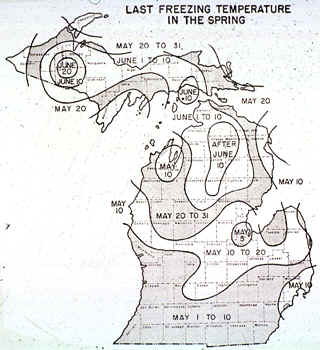
Source: Atlas of Michigan, ed. Lawrence M. Sommers, 1977.
Second, the first frost in fall is often delayed. Cold air,
invading from Canada, has to cross the (now warmer) Lake Michigan. Cold air masses are
warmed significantly as they cross the lake, and clouds formed by the exchange of heat and
moisture from the lake moderate the temperature of downwind locations even further,
significantly delaying the onset of cold weather in the late fall (relative to sites
upwind of the lakes, or farther inland). The lakeshore area is a delightful place in fall!
Third, the lake makes the hottest summer days a bit cooler.
Fruit trees essentially "shut down" when the air temperature exceed 85 degrees
F. These "extreme" high temperatures are not common near the lake, where the
cool waters and associated lake breezes keep the air cool.
Fourth, absolute minimum temperatures in winter are not
as low as inland. Fruit trees generally begin to suffer damage to their buds at
temperatures, depending upon the type and variety, of -10F to -20F. These very coldest
periods of the winter are, again, moderated by the lake, which rarely freezes and thus,
still has the ability to moderate the air at it crosses the open water. The maps
below show the number of cold (<10 and <15 degree F) days that one could normally
expect each winter, for areas in SW Lower Michigan. Note that, near the lake, the
number of such "very cold" days is less than farther inland. The lack of
(or at least, limited incidence of) extremely cold days is a positive for fruit growers,
since these very cold temperatures (found more often in inland locations) could damage the
buds on fruit trees.
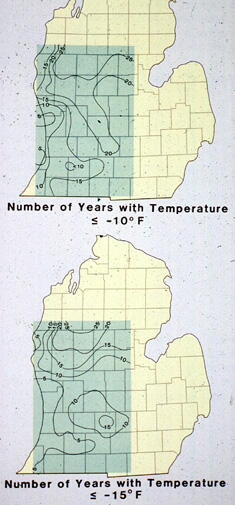
Source: The Climatic Atlas of Michigan, Val L. Eichenlaub, et al., 1990.
Thus, to sum up #3 and #4, the lakes influence air temperatures by
moderating (lowering) the highest summer temperatures, and by making the very coldest
winter days not so cold. In summer, the relatively cool lake waters cool the hot air
as it comes into contact with the lakes. In winter, the lakes release heat to the
very cold air on winter days--warming the air nearby.
Fifth, though relatively unimportant, the deep snows associated with
down-wind, lake effect sites, insulate the soil and keep it from freezing in most years.
This can potentially be beneficial with regard to root damage, though it does facilitate
the overwintering of some agronomic pests. Enhanced lake effect snows also provide a slow,
effective recharge of soil moisture in the late winter and early spring.
Sixth, lake effect lengthens the growing season--defined as the number
of days between the last spring frost and first frost in fall. The reasons why the
last spring frost comes so early and the first frost in fall arrives so late are given
above...and a map of the length of the growing season in Michigan is given below.
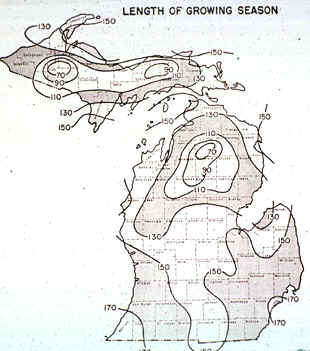
Source: Atlas of
Michigan, ed. Lawrence M. Sommers, 1977.
Finally, and perhaps most important, the area has sufficiently rolling
topography, with large local relief, to provide protection, on upland sites, from frost.
Cold air, on calm, clear nights when frost is most likely, behaves like a liquid and
drains into the low-lying parts of the landscape (see image below). These "frost
hollows" experience frost on nights when upland sites may only get down to 40 degrees
F.
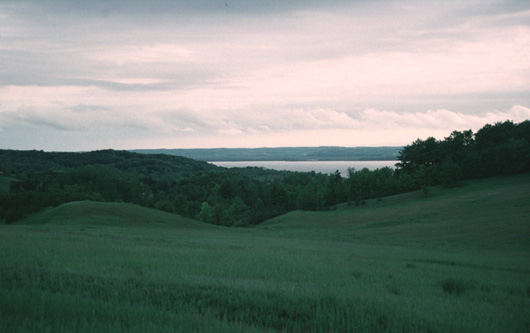
Source: Photograph by Randy Schaetzl, Professor of Geography - Michigan State University
Farmers in this region describe the landscape as a "good site" or a "cold
site", depending upon its location on the uplands or in the lowlands. It is not so
much the elevation of a site that matters, as much as its local relief and its elevation
above a nearby lowland. Notice, as we drive, that the orchards are primarily on the upland
sites. Many growers now use wind machines to stir up the cold, stagnant air that can drain
into low areas on cold nights. The warm air, above the nighttime surface inversion, is
mixed with the cold air in the lowlands, creating an atmospheric situation less conducive
to frost.
The map below provides more detail on exactly where the major fruit-growing areas in the
state actually are.
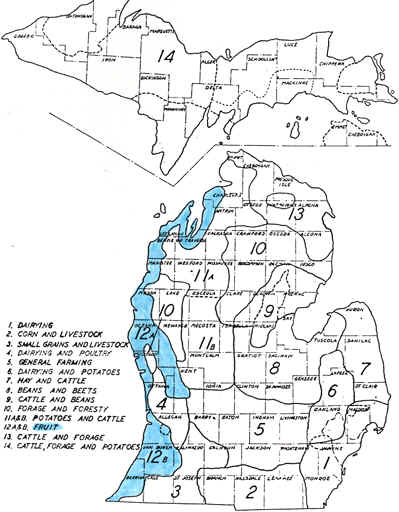
Source: Hill, E.B., Riddell, F.T., and F.F. Elliot. 1930. Types of farming in Michigan. Michigan Agricultural Experiment Station Special Bulletin 206.

Source: Unknwon
Keeping the air cool in summer (which happens near the lakes) is also important to fruit production. At temperatures in the 80's or above, many types of fruit trees "shut down" physiologically, as a way to avoid heat stress and damage. Thus, the lowered incidence of extremely hot days in summer, near the lake, is of great benefit to fruit production.
This material has been compiled for educational use only, and may not be reproduced without permission. One copy may be printed for personal use. Please contact Randall Schaetzl (soils@msu.edu) for more information or permissions.